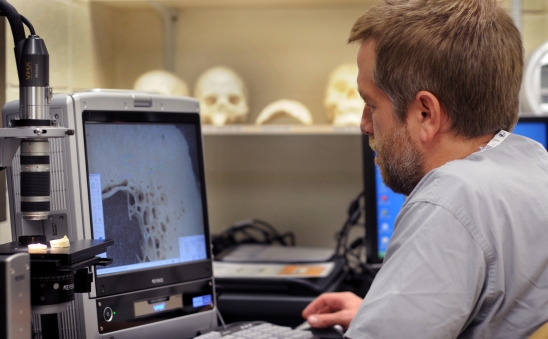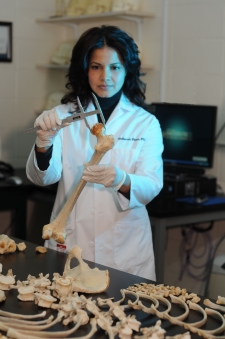Forensic Anthropology

The Forensic Anthropology Division brings expertise in skeletal recovery and analysis to the Harris County Institute of Forensic Sciences. The Division is comprised of three doctoral level physical anthropologists and an identification specialist. The forensic anthropologists are responsible for the recovery of skeletal, buried and severely burned remains; developing a skeletal profile and analysis of bone traumas, pathologies, and taphonomic changes of skeletal cases; and consulting on bone traumas and pathologies on non-skeletal cases. They are also directly involved in the identification of unidentified decedents through compiling decedent descriptions, disseminating the descriptions, and conducting skeletal radiograph comparisons to establish positive identification. Under the direction of the Anthropology Division are the Skeletal Recovery Team and the Identification Unit.
The mission of the HCIFS Forensic Anthropology Division is to provide anthropologic consultation at the direction of the medical examiner using methods and standards accepted by the field of forensic anthropology to ensure all avenues for identification are explored for each unidentified decedent, to collect and submit family reference DNA samples, to maintain records of all DNA identification cases, and to refer all unclaimed decedents for county burial.
Identification Unit
The Identification Unit (ID Unit) is an innovative yet fundamental component of the Forensic Anthropology Division. Decedents are often discovered in circumstances where there is no information regarding the individual's identity. These decedents are temporarily listed as "Unknown" or entered into the records by a tentative name. The ID Unit works with law enforcement and other resources to identify the decedent. The Identification Unit is comprised of Forensic Anthropologists and an Identification Specialist who participates in and also tracks the identification process on each of these cases.
Scientific identification is required when a person cannot be viewed by family members or is a homicide victim. A scientific identification is established when a fingerprint, dental x-ray, or skeletal x-ray taken before death is positively compared to a fingerprint, dental x-ray, or skeletal x-ray taken after death. When an appropriate record is unavailable, the DNA of the decedent is compared to the DNA of a biological relative. If a strong kinship index is established between the family reference sample and the decedent sample, the decedent is classified as positively identified through DNA comparison. All tentatively identified decedents and homicide victims must be scientifically identified prior to release from the Harris County Institute of Forensic Sciences. An exception is the release of a decedent based on a presumptive identification. A presumptive identification is made when a decedent is viewable, the family does not intend to cremate the body and the attending pathologist and Chief or Deputy Chief Medical Examiner are comfortable with the circumstances. A decedent is not cremated until positively identified.

When an unidentified decedent is received, the ID Unit staff compiles a decedent description which includes all identifying markers: the demographics (age, race, sex, and stature); scars; marks; tattoos; and personal items. The descriptions are released to local missing persons units, National Crime Information Center, HCIFS website, and National Association of Medical Examiner's Unidentified Decedent website at udrs.orainc.com. All leads gained through the various agencies are compared to the decedent descriptions for possible matches.
Friends and family members searching for a missing loved one are directed to the ID Unit. The ID Unit staff will then compare the description of the missing individual to all unknown decedents currently within the facility. ID Unit members cannot initiate a search beyond those decedents received by the HCIFS. All individuals who need to report missing loved ones are strongly encouraged to report the missing individual to law enforcement. Only a law enforcement agency can initiate a regional and national search.
The ID Unit staff also attempt to locate family or friends to notify them of a loved one's demise. If the next of kin is not found through multi-faceted search, the Identification Specialist forwards the name of the decedent to the local newspapers for assistance in locating the next of kin through a published notice. If next of kin is not found or the decedent remains unidentified, he/she is referred to Harris County Social Services Bereavement Services (HCSS) for burial. The Identification Specialist also serves as the liaison with HCSS regarding release of decedents who are eligible for low-cost county burial services.
Emergency Management
The mission of the Forensic Emergency Management Team is to ensure that the Harris County Institute of Forensic Sciences is prepared to respond to any disaster or incident that does or has the potential to disrupt the agency’s capacity to perform its function. This includes incidents that may result in a surge in the number and complexity of fatalities.
The Institute is unique among medical examiners offices in that it has integrated its Emergency Management and Forensic Investigation functions (two typically distinct functions). This integration incorporates a forward-looking emergency management perspective into the day-to-day operations of the death investigation process in the interest of maximizing the efficiency of daily operations and the emergency preparedness of the Institute as a whole. The integration results in timelier scene response, enhanced inter-agency cooperation and better overall disaster response preparedness.
The FIEM division has developed plans, trainings, and exercises to prepare the Institute to respond to a variety of incidents, including hurricanes, floods, and mass fatality incidents. The Institute’s forensic investigators are regularly incorporated into trainings and exercises along with responders from local and regional agencies to ensure our ability to work together as a team when the need arises.
In spring 2013, the region acquired a Disaster Portable Morgue Unit (DPMU) to provide the space and equipment required for mobile morgue operations. This unit is available statewide as well as within Harris County to provide full-scale morgue services should an incident occur that damages the Institute’s facility, has the potential for contamination, or requires morgue operations to be located in close proximity to an incident site.
Click below to view a time-lapse video of the DPMU set up in the span of approximately six hours.
DPMU News Coverage:
Harris County unveils new portable morgue unit KHCW/Channel 39, June 17, 2014
(En Español) Preparan morgue móvil para atender desastres Univision/Channel 45, June 18, 2014
Skeletal Recovery Team
The Skeletal Recovery Team (SRT) is a specialized unit consisting of Forensic Anthropologists and Forensic Investigators. All members of the SRT have post-graduate training in human skeletal anatomy and skeletal recovery methods. The team responds to skeletal, buried, and severely burned scenes, using organized search strategies and archaeological methods to properly search, excavate and document the scenes. The SRT works to ensure skeletal and burned decedents are fully documented and carefully recovered for medical-legal examination and identification.